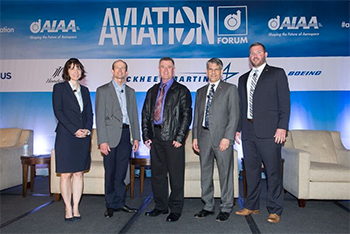Changing Culture With Electric Aviation Written 8 June 2017
Panelists: Moderator Andrew R. Gibson, president of business development and aerospace engineer, Empirical Systems Aerospace; Mike Hirschberg, executive director, AHS International — The Vertical Flight Technical Society; Amy Jankovsky, subproject manager, Hybrid Gas-Electric Propulsion, NASA’s Glenn Research Center; Matt Knapp, founder and aero CTO, Zunum Aero; Joseph Oldham, director, San Joaquin Valley Clean Transportation Center, CALSTART
by Tom Risen, Aerospace America Staff Reporter (2017-2018)

Electric-powered flight could improve safety, fuel efficiency and convenience, but innovators first have to clear regulatory hurdles and make the technology accepted as part of daily life, a panel of aviation executives and officials said June 7 during the “Aircraft Electric Propulsion: Transforming Aviation” session at the 2017 AIAA AVIATION Forum in Denver.
Automakers are leading the way in electric and hybrid electric transportation, but aviation firms have yet to win over consumers and regulators who have “grandfathered in” gasoline as the accepted aircraft fuel, said Joseph Oldham, director of the San Joaquin Valley Clean Transportation Center for CALSTART. The nonprofit Oldham works for is dedicated to the growth of clean transportation technologies.
Switching to electric-powered flight would reduce carbon emissions and save on the fluctuating cost of gasoline, but Oldham said it would also make aircraft safer by removing the risk that aviation gas would explode in a malfunction or crash.
Electric flight could also help lower costs for regional airports and consumers who travel through them, said Matt Knapp, a founder of Zunum Aero. The startup, based in Kirkland, Washington, aims to create a hybrid jet with 10 to 50 seats designed to fly on low-cost trips shorter than 1,600 kilometers. Zunum’s planes would be powered by both jet fuel and electricity and would be designed to be upgraded with “evolving energy storage capacities” as battery technology changes.
“Fuel is a highly volatile price point, and there is a cost to volatility,” Knapp said of the benefit of relying less on gasoline.
Fuel efficiency and safety are particularly important to advance vertical takeoff aircraft because hovering requires a stable and low-cost power source, Knapp said. Vertical takeoff planes were “ridiculed” and did not becoming widely used in much of the 20th century because of “a huge number of accidents,” said Mike Hirschberg, executive director of nonprofit AHS International — The Vertical Flight Technical Society. The nonprofit formerly known as the American Helicopter Society has become “laser focused on vertical flight” because of its potential to make urban travel more convenient with the help of electric power, he said.
While Hirschberg is excited about companies like Uber and Airbus trying to encourage different industries to support vertical takeoff aircraft, he discouraged the use of the term “flying car.”
A vertical takeoff craft "is not a flying car unless it drives on the road," he said.
